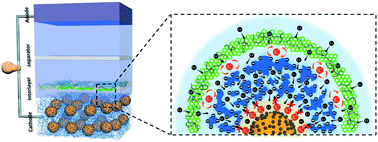Improving the Li–S battery performance by applying a combined interface engineering approach on the Li2S cathode†
Abstract
Lithium sulfide (Li2S) has been a promising candidate for Li–S battery cathode materials due to its high theoretical specific capacity and ability to be paired with safer lithium metal-free anodes. However, the low active material utilization and the short cycle life, which stem from the poor conductivity and the polysulfide dissolution–diffusion problem, hinder the further application of Li–S batteries. Herein, a combined interface engineering approach, which includes an ion-selective sulfonated poly(ether ether ketone) (SPEEK) membrane and a freestanding single wall carbon nanotube (SWCNT)/reduced graphene oxide (rGO) interlayer, has been demonstrated successfully to enhance the performance of Li–S batteries with a Li2S cathode. The SPEEK membrane is integrated into the Li2S cathode, functioning as both a barrier of the polysulfides and a highway for Li+ ions, due to its negatively charged ionic nanochannels which have been proved to mediate high-speed ion transport. With SPEEK, the cell presents high rate performance (above 400 mA h g−1 at 10 A g−1). Furthermore, to balance the conductivity of ions and electrons, a SWCNT/rGO interlayer is inserted between the cathode and the separator to improve the electronic conductivity, block the polysulfides, and provide space for sustained electrochemical reactions, resulting in improved capacity and life. With the interlayer, a high capacity of 620 mA h g−1 is retained after 80 cycles.



 Please wait while we load your content...
Please wait while we load your content...